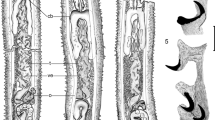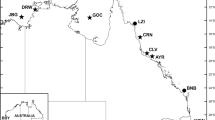Abstract
Selachohemecus benzi Bullard & Overstreet n. sp. infects the heart and kidney of the blacktip shark Carcharhinus limbatus in the northern Gulf of Mexico off Florida and Mississippi, USA. Specimens of S.␣olsoni Short, 1954, the only congener and only other named blood fluke reported from a chondrichthyan in the Gulf of Mexico, were collected from the heart of the Atlantic sharpnose shark Rhizoprionodon terraenovae from two new localities, Apalachicola Bay, Florida, and Mississippi Sound, Mississippi, USA. The new species differs from S. olsoni by having a larger body (1.4–3.8 mm long), robust tegumental body spines numbering 51–63 along each lateral body margin, a testis extending from the posterior caeca to the ovary, and a medial ovary with lobes. We amend the diagnosis of Selachohemecus Short, 1954 to accommodate it and provide a diagnostic key for all named chondrichthyan blood flukes.
Similar content being viewed by others
References
Bray R.A., Cribb T.H. (2003) The digeneans of elasmobranchs - distribution and evolutionary signficance. In: Combes C., Jourdane J. (eds) Taxonomy, ecology and evolution of metazoan parasites - Livre hommage au Professeur Louis Euzet. Les Presses Universitaires de Perpignan, Perpignan, pp. 67–96
Bullard S.A., Overstreet R.M. (2003) Elaphrobates euzeti gen. and sp. n. (Digenea: Sanguinicolidae) from snappers (Lutjanidae) in the Gulf of Mexico. In: Combes C., Jourdane J. (Eds.) Taxonomy, ecology and evolution of metazoan parasites - Livre hommage au Professeur Louis Euzet. Les Presses Universitaires de Perpignan, Perpignan, pp. 97–113
Bullard S.A., Overstreet R.M. (2004) Two new species of Cardicola (Digenea: Sanguinicolidae) in drums (Sciaenidae) from Mississippi and Louisiana. Journal of Parasitology 90: 128–136
Compagno L.J.V. (1988) Sharks of the Order Carcharhiniformes. Princeton University Press, Princeton, New Jersey, pp. 486
Kamegai S., Machida M., Kuramochi T. (2002) Two blood flukes from deep-sea fishes of Suruga Bay, Japan. Bulletin of the National Science Museum Series A (Zoology) 28: 29–34
Karlsbakk E., Aspholm P.E., Berg V. Hareide N.R., Berland B. (2002) Some parasites of the small-eyed rabbitfish, Hydrolagus affinis (Capello, 1867) (Holocephali), caught in the deep waters off SW Greenland. Sarsia 87: 179–184
Lockyer A.E., Olson P.D., Østergaard P., Rollinson D., Johnston D.A., Attwood S.A., Southgate V.R., Horak P., Snyder S.D., Le T.H., Agatsuma T., McManus D.P., Carmichael A.C., Naem S., Littlewood D.T.J. (2003) The phylogeny of the Schistosomatidae based on three genes with emphasis on the interrelationships of Schistosoma Weinland, 1858. Parasitology 126:203–224
Madhavi R., Rao K.H. (1970) Orchispirium heterovitellatum gen. et sp. nov. (Trematoda: Sanguinicolidae) from the ray fish, Dasyatis imbricatus Day, from Bay of Bengal. Journal of Parasitology 56:41–43
Maillard C., Ktari M.H. (1978) Hyperandrotrema cetorhini n. g., n. sp. (Trematoda, Sanguinicolidae) parasite du système circulatoire de Cetorhinus maximus (Selacii). Annales de Parasitologie Humane et Comparée 53: 359–365
McIntosh A. (1934) A new blood trematode, Paradeontacylix sanguinicoloides n. g., n. sp., from Seriola lalandi with a key to the species of the family Aporocotylidae. Parasitology 26: 463-467
Ogawa K., Egusa S. (1986) Two new species of Paradeontacylix McIntosh, 1934 (Trematoda: Sanguinicolidae) from the vascular system of a cultured marine fish, Seriola purpurascens. Fish Pathology 21: 15-19
Short R.B. (1954) A new blood fluke, Selachohemecus olsoni, n. g., n. sp. (Aporocotylidae) from the sharp-nosed shark, Scoliodon terra-novae. Proceedings of the Helminthological Society of Washington 21: 78–82
Smith J.W. (1972) The blood flukes of cold-blooded vertebrates and some comparison with the schistosomes. Helminthological Abstracts 41: 161–204
Smith J.W. (1997) The blood flukes (Digenea: Sanguinicolidae and Spirorchidae) of cold-blooded vertebrates: Part 2. Appendix I: Comprehensive parasite-host list; Appendix II: Comprehensive host-parasite list. Helminthological Abstracts 66: 329–344
Smith J.W. (2002) Family Sanguinicolidae von Graff, 1907. In: Gibson D.I., Jones A., Bray R.A. (eds). Keys to the Trematoda. Vol. 1. CAB International and The Natural History Museum, Wallingford, pp. 433–452
Sproston N.G. (1948) On the genus Dinobothrium van Beneden (Cestoda), with a description of two new species from sharks, and a note on Monorygma sp. from the electric ray. Parasitology 39: 73–90
Van der Land J. (1967) A new blood fluke (Trematoda) from Chimaera monstrosa L. Proceedings. Koninklijke Nederlandse Akademie van Wetenschappen, Section C, Biological and Medical Sciences 70: 110–120
Acknowledgements
We thank R. Palmer (Gulf Coast Research Laboratory [GCRL], The University of Southern Mississippi [USM]) for helping collect the initial specimens of S. benzi in 1995; J. Braswell (INVISTA Incorporated, Dalton Carpet Technology Center, Dalton, Georgia) for help with the scanning electron microscopy; C. Schloss, J.␣Shaw and M. Williams (The Gunter Library, GCRL, USM) for bibliographic assistance; J.␣Brusher, E.␣Cortes and D. Bethea (Shark Population Assessment Group, National Oceanic and Atmospheric Administration [NOAA], National Marine Fisheries Service [NMFS], Panama City, Florida) for helping collect sharks in Apalachicola Bay, Florida, and adjacent waters; R. Hueter, M. Henry and R. Pierce (Mote Marine Laboratory, Sarasota, Florida) for facilitating collections of sharks from Tampa Bay, Florida; J.␣Petersen, J.␣Steckler, L. Galle and N. Jordan (GCRL) for helping collect sharks off Mississippi; M. Grace, W. Ingram and the officers and crew of the R/V Gordon Gunter and R/V Oregon II (NOAA, NMFS, Pascagoula, Mississippi) for allowing SAB to examine their catch; and G. Benz for helping examine sharks aboard the R/V Gordon Gunter. Grants from the United States Environmental Protection Agency, Gulf of Mexico Program (Award No. MX994732-95-0), National Oceanic and Atmospheric Association (National Marine Fisheries Service Award NA06FL0501), and a Doctoral Dissertation Improvement Grant from the National Science Foundation (NSF Award No. 0508856) supported this study.
Author information
Authors and Affiliations
Corresponding author
Rights and permissions
About this article
Cite this article
Bullard, S.A., Overstreet, R.M. & Carlson, J.K. Selachohemecus benzi n. sp. (Digenea: Sanguinicolidae) from the blacktip shark Carcharhinus limbatus (Carcharhinidae) in the northern Gulf of Mexico. Syst Parasitol 63, 141–152 (2006). https://doi.org/10.1007/s11230-005-9010-x
Received:
Accepted:
Published:
Issue Date:
DOI: https://doi.org/10.1007/s11230-005-9010-x




